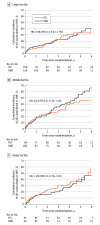Viability and Outcomes With Revascularization or Medical Therapy in Ischemic Ventricular Dysfunction: A Prespecified Secondary Analysis of the REVIVED-BCIS2 Trial
- PMID: 37878295
- PMCID: PMC10600721
- DOI: 10.1001/jamacardio.2023.3803
Viability and Outcomes With Revascularization or Medical Therapy in Ischemic Ventricular Dysfunction: A Prespecified Secondary Analysis of the REVIVED-BCIS2 Trial
Abstract
Importance: In the Revascularization for Ischemic Ventricular Dysfunction (REVIVED-BCIS2) trial, percutaneous coronary intervention (PCI) did not improve outcomes for patients with ischemic left ventricular dysfunction. Whether myocardial viability testing had prognostic utility for these patients or identified a subpopulation who may benefit from PCI remained unclear.
Objective: To determine the effect of the extent of viable and nonviable myocardium on the effectiveness of PCI, prognosis, and improvement in left ventricular function.
Design, setting, and participants: Prospective open-label randomized clinical trial recruiting between August 28, 2013, and March 19, 2020, with a median follow-up of 3.4 years (IQR, 2.3-5.0 years). A total of 40 secondary and tertiary care centers in the United Kingdom were included. Of 700 randomly assigned patients, 610 with left ventricular ejection fraction less than or equal to 35%, extensive coronary artery disease, and evidence of viability in at least 4 myocardial segments that were dysfunctional at rest and who underwent blinded core laboratory viability characterization were included. Data analysis was conducted from March 31, 2022, to May 1, 2023.
Intervention: Percutaneous coronary intervention in addition to optimal medical therapy.
Main outcomes and measures: Blinded core laboratory analysis was performed of cardiac magnetic resonance imaging scans and dobutamine stress echocardiograms to quantify the extent of viable and nonviable myocardium, expressed as an absolute percentage of left ventricular mass. The primary outcome of this subgroup analysis was the composite of all-cause death or hospitalization for heart failure. Secondary outcomes were all-cause death, cardiovascular death, hospitalization for heart failure, and improved left ventricular function at 6 months.
Results: The mean (SD) age of the participants was 69.3 (9.0) years. In the PCI group, 258 (87%) were male, and in the optimal medical therapy group, 277 (88%) were male. The primary outcome occurred in 107 of 295 participants assigned to PCI and 114 of 315 participants assigned to optimal medical therapy alone. There was no interaction between the extent of viable or nonviable myocardium and the effect of PCI on the primary or any secondary outcome. Across the study population, the extent of viable myocardium was not associated with the primary outcome (hazard ratio per 10% increase, 0.98; 95% CI, 0.93-1.04) or any secondary outcome. The extent of nonviable myocardium was associated with the primary outcome (hazard ratio, 1.07; 95% CI, 1.00-1.15), all-cause death, cardiovascular death, and improvement in left ventricular function.
Conclusions and relevance: This study found that viability testing does not identify patients with ischemic cardiomyopathy who benefit from PCI. The extent of nonviable myocardium, but not the extent of viable myocardium, is associated with event-free survival and likelihood of improvement of left ventricular function.
Trial registration: ClinicalTrials.gov Identifier: NCT01920048.
Conflict of interest statement
Figures



Comment in
-
Realigning Priorities in the Evaluation and Management of Patients With Heart Failure.JAMA Cardiol. 2023 Dec 1;8(12):1163-1164. doi: 10.1001/jamacardio.2023.3900. JAMA Cardiol. 2023. PMID: 37878287 No abstract available.
-
Assessment of Myocardial Viability in Ischemic Cardiomyopathy-Scarred by the Data but Still Alive.JAMA Cardiol. 2023 Dec 1;8(12):1161-1163. doi: 10.1001/jamacardio.2023.3846. JAMA Cardiol. 2023. PMID: 37878293 No abstract available.
References
-
- Allman KC, Shaw LJ, Hachamovitch R, Udelson JE. Myocardial viability testing and impact of revascularization on prognosis in patients with coronary artery disease and left ventricular dysfunction: a meta-analysis. J Am Coll Cardiol. 2002;39(7):1151-1158. doi:10.1016/S0735-1097(02)01726-6 - DOI - PubMed
-
- Ling LF, Marwick TH, Flores DR, et al. . Identification of therapeutic benefit from revascularization in patients with left ventricular systolic dysfunction: inducible ischemia versus hibernating myocardium. Circ Cardiovasc Imaging. 2013;6(3):363-372. doi:10.1161/CIRCIMAGING.112.000138 - DOI - PubMed
MeSH terms
Associated data
Grants and funding
LinkOut - more resources
Full Text Sources
Medical
Miscellaneous

